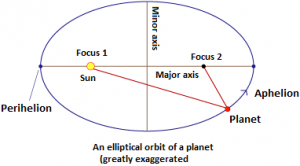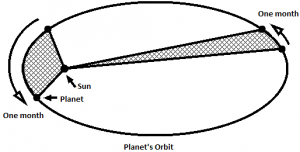Johannes Kepler – The Story: The German astronomer, Johannes Kepler was born in the year 1571. When he was training to become a minister, he came across the work of Nicolaus Copernicus. At that time it was believed that the sun and other planets orbit the earth and not how as we know it now (everything orbits the sun). Copernicus however, hypothesized that the earth and other planets orbit the sun. He had no proof of this though. All these theories were derided by the church in any case and as everyone knows Galileo was even thrown in jail.
With his continued work in astronomy, he impressed a Danish astronomer, Tycho Brahe, who then invited him to Prague to work with him. This wealthy Danish guy had an observatory where he kept detailed information about planetary motions. This would have solved the many questions Kepler had, right?
Bad luck. Brahe didn’t trust Kepler. He thought that his much smarter assistant may surpass him and become the astronomer of the age. Because of this he didn’t let Kepler access all his data. When Brahe passed away, Kepler finally had access to his data (he kind of stole it). Using this he solved the very confusing Martian problem (varying speeds and distances of the planet observed at different times) and through this formulated the Kepler’s Laws of Planetary Motion that he is famous for.
Kepler’s three laws of planetary motion:
Kepler’s First Law: The planets move around the Sun in an elliptical orbit with the Sun at one focus of the ellipse.
As mentioned in the short biography of Kepler, his first law was a result of a great insight that planets did not necessarily move in perfect circular orbits, which had been long assumed. Using Tycho’s measurements of the motion of Mars across the sky, Kepler discovered planets move in elliptical orbits with the sun not at the centre of the ellipse, but at one focus (the other focus is empty). It’s a deceptively simple law that took astonishing insight and five year of hard work. Kepler’s Second Law: The line from the sun to a planet sweeps out equal areas in equal times.
Kepler’s Second Law: The line from the sun to a planet sweeps out equal areas in equal times.
As you may have surmised, if a planet traverses an elliptical orbit, its distance from the sum changes during an orbit. Kepler noticed, using Tycho’s real – world observations that planets seemed to speed up in their orbits when they are closer to the sun and slow down when they are further away. The effect was subtle but unmistakable. But a verbal description was insufficient. Kepler had to quantify this motion, and did so by stating that “a line joining a planet and the sun sweeps out equal areas during equal intervals of time”. “Who cares”, you might ask? This doesn’t affect your everyday life and enjoyment of the night sky, but Kepler’s 2nd Law is a) Critical for predicting where we can see planets in the sky, and b) A direct consequence of the great universal law of “conservation of energy”. As a planet gets closer to the Sun, it has less “potential energy” and more “kinetic energy”, and as it moves away from the Sun, it has the opposite. Without this law, we would still be scratching our head about where and when the planets appear in the night sky.
“Who cares”, you might ask? This doesn’t affect your everyday life and enjoyment of the night sky, but Kepler’s 2nd Law is a) Critical for predicting where we can see planets in the sky, and b) A direct consequence of the great universal law of “conservation of energy”. As a planet gets closer to the Sun, it has less “potential energy” and more “kinetic energy”, and as it moves away from the Sun, it has the opposite. Without this law, we would still be scratching our head about where and when the planets appear in the night sky.
Kepler’s Third Law: Law of Harmonics or Law of periods
Planets farther away from the sun have larger orbits, so even if they moved at the same speed as the closer in planets, you did expect them to take longer to move around the sun. And they do. But they also move at a lower rate of speed, which further lengthens the time is takes to revolve around the sun. What Kepler discovered to be exact, is that the square of the orbital period (P) of a planet is directly proportional to the cube of the semi major axis of its orbit (T).
P² α T³
The planets move slower when they’re farther from the Sun, and whatever influence makes planets go around the Sun weakens with distance. It was left to the great British scientist and world-historical genius, Isaac Newton, to explain this relationship with his own law of gravity, a law upon which all of modern physical science is based.
Kepler’s three laws appear to hold not just in our own solar system, but in all circumstances where one body moves under the influence of another’s gravity. They are general universal relationships.
